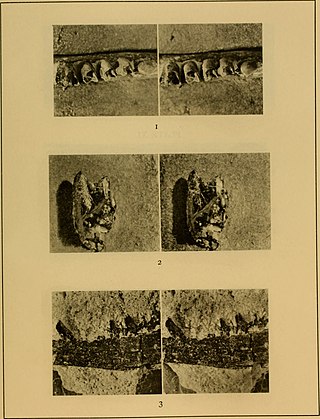
Ctenacodon is a genus of extinct mammal that lived in what is now North America during the Upper Jurassic period. It is a member of the family Allodontidae within the order Multituberculata. Ctenacodon, also known as Allodon, was named by Othniel Charles Marsh in 1879. At least three species are currently recognized.
Psalodon is an extinct genus of North American mammal that lived during the Upper Jurassic period. It's a member of the family Allodontidae within the order Multituberculata.
Enneabatrachus is an extinct genus of prehistoric frogs known from the late Jurassic Morrison Formation of the United States and also the Late Jurassic-Early Cretaceous Ksar Metlili Formation of Morocco. The type species is E. hechti, whose remains have been recovered from stratigraphic zone 5.
Aploconodon is an extinct genus of Late Jurassic mammals belonging to the family Amphidontidae. It contains one species, A. comoensis.

Priacodon is an extinct genus of Late Jurassic eutriconodont mammal from the Alcobaça Formation of Portugal and the Morrison Formation of the midwestern United States. It is present in stratigraphic zones 4–6 of the latter. The genus contains four known species: Priacodon ferox, Priacodon fruitaensis, Priacodon lulli and Priacodon robustus.
Trioracodon is an extinct genus of Late Jurassic to Early Cretaceous eutriconodont mammal found in North America and the British Isles. It was named in 1928
Comodon is an extinct genus of Late Jurassic mammal from the Morrison Formation of Wyoming. Fossils of this taxon are present in stratigraphic zone 5.
Triconolestes is an extinct genus of Late Jurassic eutriconodont mammal from the Morrison Formation, present in stratigraphic zones 4. Known from only a single molar, it is a small mammal typically considered an amphilestid. However, it has also been compared to Argentoconodon, which has been considered a volaticothere related to gliding mammals such as Volaticotherium and Ichthyoconodon.
Tinodon is an extinct genus of mammal alive 155–140.2 million years ago (Oxfordian-Berriasian) which has been found in the Morrison Formation, the Alcobaça Formation (Portugal) and the Lulworth Formation (England). It is of uncertain affinities, being most recently recovered as closer to therians than eutriconodonts but less so than allotherians. Two species are known: T. bellus and T. micron.
Amblotherium is an extinct genus of Late Jurassic and Early Cretaceous mammal. The type species Amblotherium pusillum is from the Lulworth Formation of southern England, while the referred species Amblotherium gracile is from stratigraphic zones 2, 3 and 5 of the Morrison Formation of the US.

Paurodon is an extinct genus of Late Jurassic mammal from the Morrison Formation of the Western United States.
Tathiodon is an extinct genus of Late Jurassic mammal from the Morrison Formation. Present in stratigraphic zone 5.

Laolestes is an extinct genus of dryolestid mammal. Fossil remains are known from the Morrison Formation, in stratigraphic zones 5 and 6., the Late Jurassic of Portugal, and Early Cretaceous Wadhurst Clay of the United Kingdom.

Dryolestes is an extinct genus of Late Jurassic mammal from the Morrison Formation and the Alcobaça Formation of Portugal. The type species Dryolestes priscus is present in stratigraphic zones 2, 5, and 6.
Comotherium is an extinct genus of Late Jurassic mammal from the Morrison Formation. Present in stratigraphic zone 5.
Euthlastus is an extinct genus of Late Jurassic mammal from the Morrison Formation. Present in stratigraphic zones 5 and 6. It is represented by only five upper molars.
Theretairus is a Late Jurassic genus of sphenodont reptile from the Morrison Formation of western North America, present in stratigraphic zones 5 and 6.
Schillerosaurus was a genus of prehistoric lizard of the Late Jurassic Morrison Formation of Western North America, and is currently the only squamate genus known to be endemic to the Morrison Formation. Described based on a partial skeleton from Dinosaur National Monument by Susan Evans and Dan Chure in 1999 as Schilleria utahensis, its name was subsequently changed to Schillerosaurus due to the former name already being occupied by a modern-day arachnid subgenus.
Saurillodon is a genus of prehistoric lizard of the Late Jurassic of Portugal, UK and Morrison Formation of Western North America.
Parviraptor is a genus of squamate containing one species, Parviraptor estesi, from the Late Jurassic (Tithonian) or Early Cretaceous (Berriasian) Purbeck Limestone Formation of Dorset, England. A second species, Parviraptor gilmorei, was described from the Late Jurassic Morrison Formation of Western North America; it was present in stratigraphic zone 4. However, the second species was subsequently transferred to a separate genus Diablophis. An indeterminate species is known from the Bathonian aged Kirtlington Mammal Bed.








